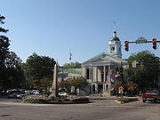
Aiken, South Carolina
Overview
Aiken is a city in and the county seat
of Aiken County
, South Carolina
, United States
. With Augusta, Georgia
, it is one of the two largest cities of the Central Savannah River Area
. It is part of the Augusta-Richmond County Metropolitan Statistical Area
. Aiken is home to the University of South Carolina at Aiken
. The population was 29,494 at the 2100 census. Aiken was recognized with the All-America City Award
in 1997 by the National Civic League
.
Aiken is located at 33°32′58"N 81°43′14"W (33.549397, -81.720689).
According to the United States Census Bureau
, the city has a total area of 16.2 square miles (42 km²).
Population in 1890, 2,362; in 1900, 3,414; in 1910, 3,911; in 1940, 6,168.
County seat
A county seat is an administrative center, or seat of government, for a county or civil parish. The term is primarily used in the United States....
of Aiken County
Aiken County, South Carolina
Aiken County is a county located in the U.S. state of South Carolina. In 2000, its population was 142,552; in 2010, the U.S. Census Bureau estimated that its population had reached 160,099...
, South Carolina
South Carolina
South Carolina is a state in the Deep South of the United States that borders Georgia to the south, North Carolina to the north, and the Atlantic Ocean to the east. Originally part of the Province of Carolina, the Province of South Carolina was one of the 13 colonies that declared independence...
, United States
United States
The United States of America is a federal constitutional republic comprising fifty states and a federal district...
. With Augusta, Georgia
Augusta, Georgia
Augusta is a consolidated city in the U.S. state of Georgia, located along the Savannah River. As of the 2010 census, the Augusta–Richmond County population was 195,844 not counting the unconsolidated cities of Hephzibah and Blythe.Augusta is the principal city of the Augusta-Richmond County...
, it is one of the two largest cities of the Central Savannah River Area
Central Savannah River Area
The Central Savannah River Area is a 13-county region in the U.S. state of Georgia, and is also considered to include five to eight counties in South Carolina. The term was coined in 1950 by C.C. McCollum, the winner of a $250 contest held by The Augusta Chronicle to generate the best name for the...
. It is part of the Augusta-Richmond County Metropolitan Statistical Area
Augusta-Richmond County Metropolitan Statistical Area
The Augusta–Richmond County Metropolitan Statistical Area, as defined by the United States Census Bureau, is an area consisting of six counties in the Central Savannah River Area , anchored by the city of Augusta, Georgia...
. Aiken is home to the University of South Carolina at Aiken
University of South Carolina Aiken
The University of South Carolina Aiken is a four-year, public coeducational university in Aiken, South Carolina. The school offers undergraduate degree programs as well as master's degrees in elementary education, educational technology and applied clinical psychology...
. The population was 29,494 at the 2100 census. Aiken was recognized with the All-America City Award
All-America City Award
The All-America City Award is given by the National Civic League annually to ten cities in the United States.The oldest community recognition program in the nation, the award recognizes communities whose citizens work together to identify and tackle community-wide challenges and achieve uncommon...
in 1997 by the National Civic League
National Civic League
The National Civic League is an American non-profit organization that advocates for transparency, effectiveness, and openness in local government...
.
Aiken is located at 33°32′58"N 81°43′14"W (33.549397, -81.720689).
According to the United States Census Bureau
United States Census Bureau
The United States Census Bureau is the government agency that is responsible for the United States Census. It also gathers other national demographic and economic data...
, the city has a total area of 16.2 square miles (42 km²).
Population in 1890, 2,362; in 1900, 3,414; in 1910, 3,911; in 1940, 6,168.

